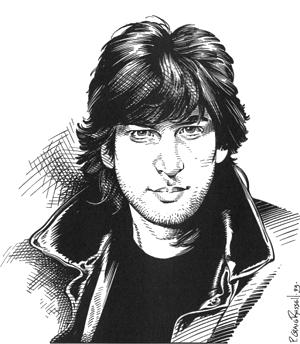An Evening with Neil Gaiman - What are stories for?
By Clayton MacGillivray
March 13, 2014 - 10:09
 |
Gaiman, the 2014 Distinguished Visiting Writer for the Calgary Distinguished Writers Program, charmed the 1100 attendees by complimenting them on their fast reflexes; a reference to the fact that all tickets to the talk were claimed online within one minute of their release.
Between short stories and poems including Click-Clack the Rattlebag, The Day the Saucers Came, Feminine Endings and My Last Landlady, Gaiman shared personal insights into the craft of writing.
He began by relating how as a journalist in England during the 1980s he interviewed successful authors who were unable to publish books that were outside of their accepted oeuvre, including one science fiction author who could not publish a book set in 19th century Mississippi. Gaiman said he never wanted to be so successful that he was “put in a box to do one thing over again and again;” that he is fortunate to be in a position to write what he wants to write.
He then tackled the one question that no author likes to be asked – where do you get your ideas? In jest, he claimed that they come from the ideas shop or the idea of the month club. But then answered truly that stories come from confluences, from things we take for granted coming together. As an example, he wondered what would happen if a werewolf bit a goldfish, or a chair?
When asked why bother to write poetry when the world no longer seems to read this genre he asserted that a writer writes to communicate, to get something out of their head, to irritate, to inspire, to share their point of view.
“You make art and you make the best art you can. You don’t worry whether someone reads it or not. Poetry, short stories, plays still matter.”
Next, Gaiman recalled a speaking engagement in Billings, Montana during which he was asked what he considers to be the best question put to him to date. A seven year old girl wanted to know if he had ever burped so hard that it hurt. After the laughter ended he left the question unanswered but did share one very personal anecdote to illustrate what stories are for.
He recounted how his cousin Helen lived in the Warsaw ghetto during the Second World War and each night would secretly read a German translation of Gone with the Wind by candlelight in her room. She did this despite the fact that it was against the law for her to possess a book and knowing that if she was discovered she would be put to death. Each day she would relate what happened in the story of Scarlett O'Hara and Rhett Butler to the young girls she taught so that they too could escape the horrors of their lives for a short time.
With that, Gaiman explained that he believes that stories teach us that we are not alone. That we get only one life, but that if we read, and if we read fiction, we get hundreds of lives, thousands of lives.
With all questions answered, Gaiman finished with one last poem, In Relig Odhrain. The crowd then rose in a standing ovation to thank him for the opportunity he had afforded them to live thousands of lives and for providing a greater understanding of what stories are for.
Related Articles:
The Art of Neil Gaiman book review
An Evening with Neil Gaiman - What are stories for?
McFarlane Sticking the Middle Finger to Gaiman with Miracleman
The Binquirer, Post-Con Edition: The future of Waid's Thrillbent, new Marvel movies, Neil Gaiman's return to Vertigo, and much more!
Comic Con: Neil Gaiman Reteams with Vertigo for Sandman Mini
Detective Comics #853 as a Neil Gaiman Event
Batman #686 as a Neil Gaiman Event
Batman #686: Gaiman Continues in Morrison's Footsteps
Neil Gaiman's The Graveyard Book
On Neil Gaiman in The Sandman Papers
